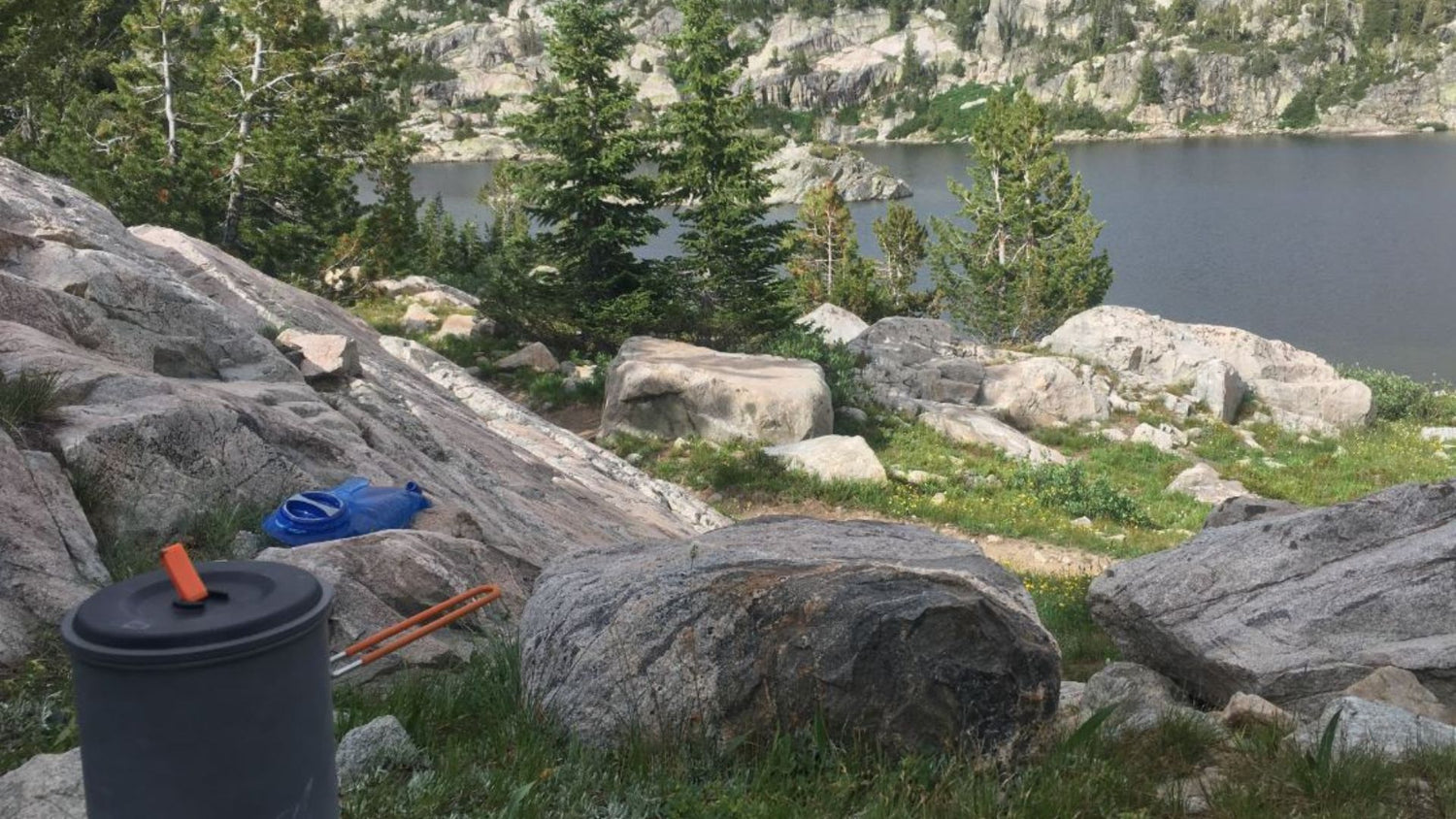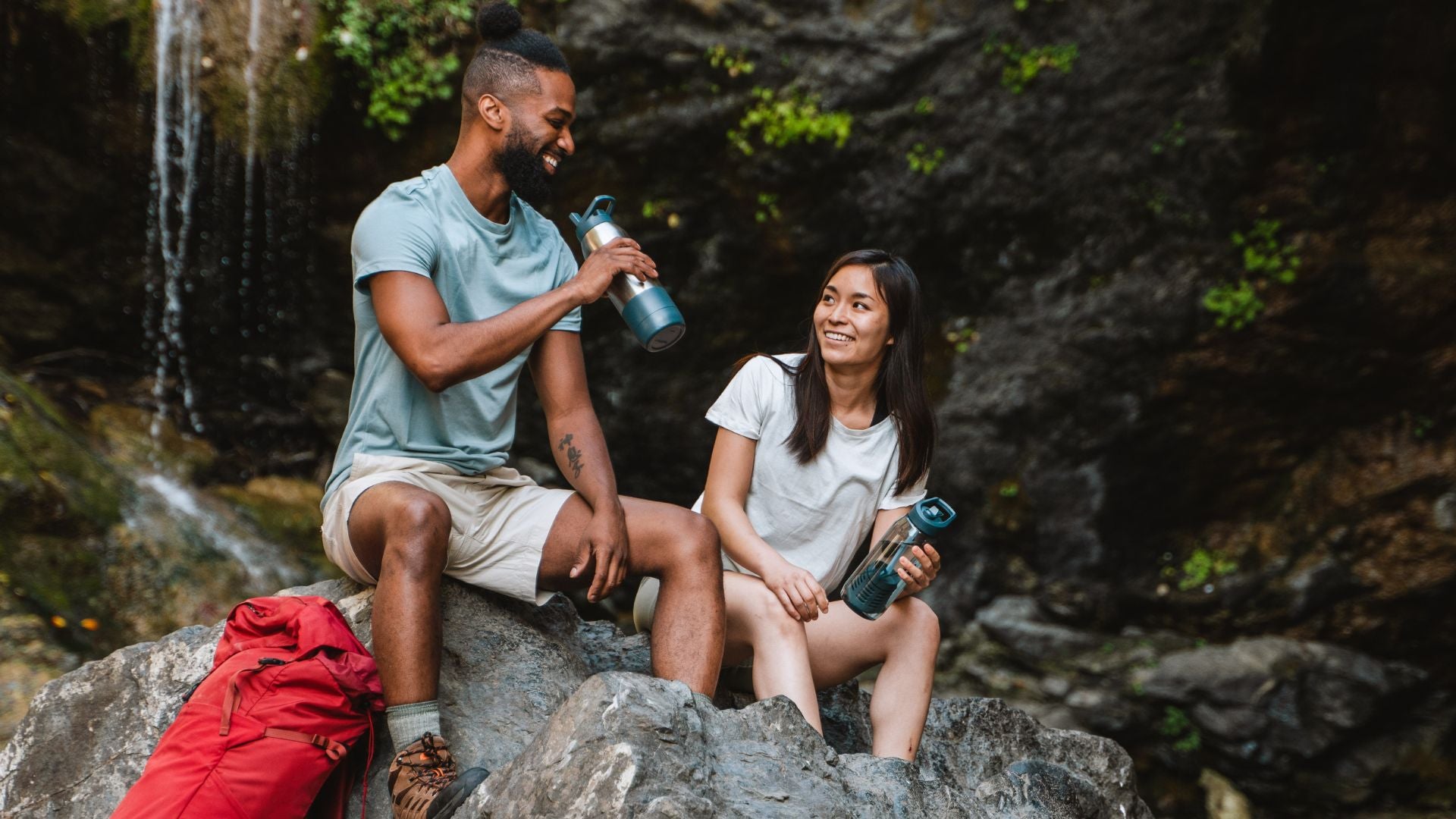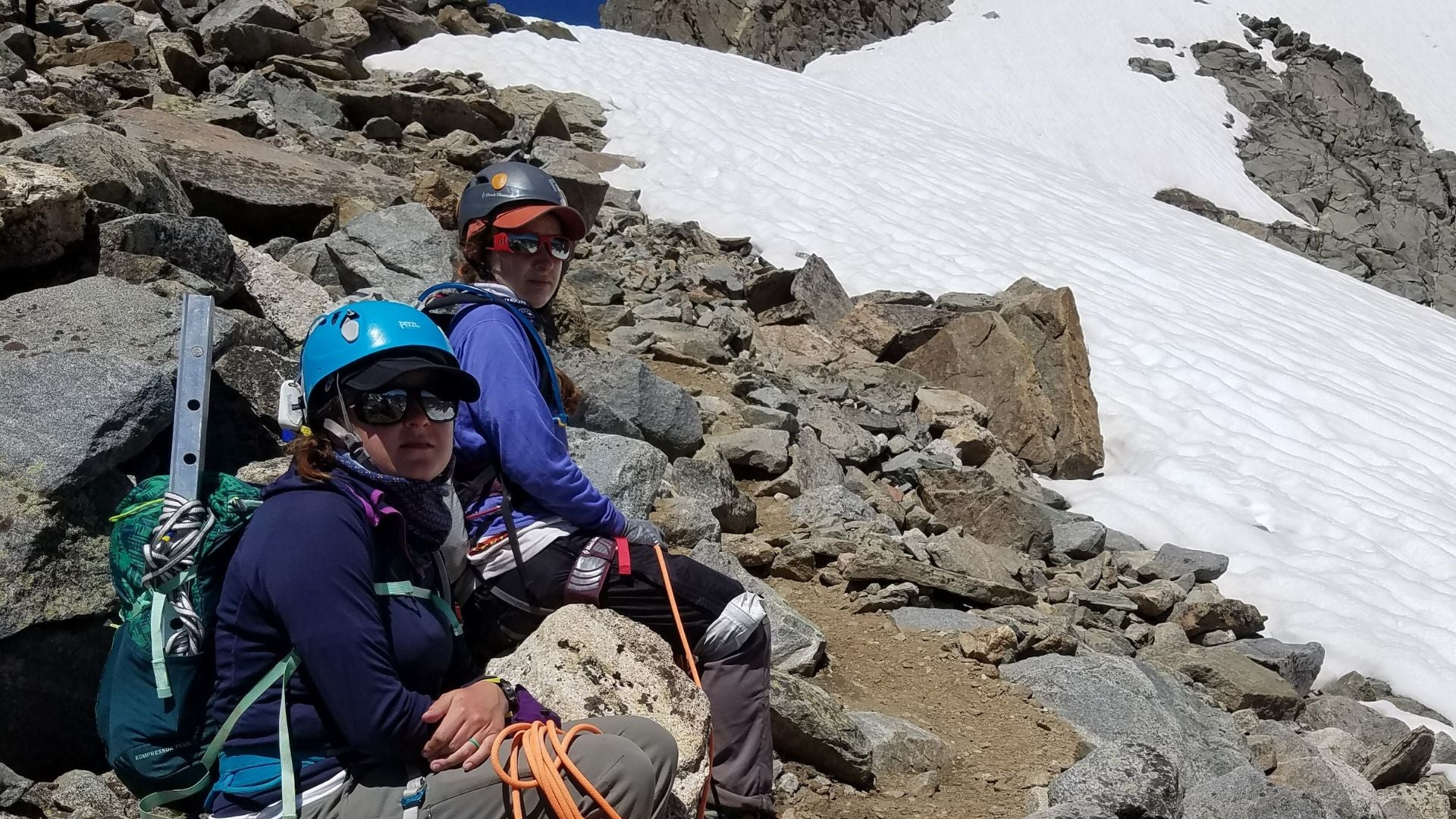Logistics Guru and Backcountry Chef for this backpacking Expedition, Chelsea Miller helped her team stay organized and well-fed for a week spent in the Wind River Range. Below, she gave us the inside scoop on making ultralight backpacking meals and cooking techniques, as well as some recipes you’ll be dying to hit the trail and try for yourself.
Backpacking Meals: A Balance of Taste & Weight
 For our meals in the Wind River Range, I only had to boil water to make a tasty, nutritious meal!
For our meals in the Wind River Range, I only had to boil water to make a tasty, nutritious meal!
At home, I love cooking elaborate meals with fresh ingredients. This means that I often get a little too excited about backpacking meals and cooking, lugging potatoes, cans of coconut milk, blocks of cheese, and large pots on backpacking trips. Much to the chagrin of my team, I also end up weighing down their packs. We only needed to carry a stove and a small pot.
For our trip, I knew our packs would already be weighed down with the gear required for glacier travel. I wanted to minimize the impact food would have on our packs while keeping dinner interesting and nutritious. To do this, I opted for freezer bag style cooking. All of our ingredients were essentially instant and only needed to soak in hot water for five minutes before eating. This meant that we only needed to carry a stove and a small pot in order to have a hot meal every night. With all the gear we had to carry, my goal was to make our meals as light as possible.
With all the gear we had to carry, my goal was to make our meals as light as possible.
Every night, I would boil a pot of water (we used this pot set and this stove), pour the water into the freezer bag holding that night’s meal, put the freezer bag in an insulator (I can’t find the exact one we used, and this one is much fancier than what we used. Honestly, you can use foil insulation and duct tape to make a workable cozy.), and then wait for a long five minutes until we were enjoying a delicious hot meal. (While cooking directly in the freezer bag worked best for us because we only wanted to carry a small pot for the four of us and not need to clean it each night, you can also opt to cook this right in a pot or in your mess kit.) I prepped and cooked our meals in freezer bags, which was super convenient.
I prepped and cooked our meals in freezer bags, which was super convenient.
This process worked really well for us on the trail, and it only took me an hour at home to assemble meals for four for a week.
The Basic Formula
Building these backpacking meals felt like an Iron Chef challenge where the secret ingredient was dehydrated chicken, which was in every meal I made. I wanted our meals to be well balanced and calorie dense. Therefore, I followed a basic formula for every recipe: protein, instant carbs, dehydrated vegetables and spices.
As I just mentioned, I opted for freeze dried chicken, but Mountain House has lots of different options if you want to mix it up even more. For a carb base, I used couscous, instant rice, instant potatoes, and rice noodles (depending on the meal). All of these only need to soak in hot water, rather than foods that need to cook such as pasta, quinoa, or rice. To pick a carb base that will work, make sure the cooking instructions either tell you to “remove from heat and let sit” or to boil for less than 3 minutes. (Note: for the rice noodles, we cooked them separately then added them to the spice and chicken mixture. We wanted to soak them and then drain off the water to make sure our sauce wasn’t too watery.) For the Thai Peanut Noodles dinner, I cooked the rice noodles separately to drain off the water.
For the Thai Peanut Noodles dinner, I cooked the rice noodles separately to drain off the water.
To every meal, I added dehydrated vegetables and chia seeds for an added nutritional boost. In order to “spice” things up, I added things like curry powder, Parmesan cheese, and garlic to create different flavors.
Backcountry Test Kitchen
As this was my first time cooking this way, I wanted to make sure the backpacking meals were going to turn out OK before we headed off on the trip. My first attempt, which was tasted by the team after an evening of practicing our ice axe skills on the snow patches left on Cannon Mountain, did not pan out well. I attempted to make a Fettuccine Alfredo with noodles that cooked in 5 minutes, and we attempted to make the meal in our individual bowls by divvying up the mix ahead of time, instead of cooking it all together in the freezer bag. We were left with watery, yet still crunchy noodles in a rapidly cooling sauce. This was the last thing we would want after a long day of hiking in the Wind River Range.
I adjusted the cook time of my carbohydrate base and opted to cook in the freezer bag insulator, which led to more success. I sent Couscous Alfredo and Shepherd’s Pie along with Joe on his climb up Mt. Whitney in June, and Jenny and I sampled the Curried Couscous on a weekend trip through the White Mountains. All of these test runs went smoothly; getting to test the recipes before we started on our trip helped me build confidence that these would actually work when we were on the trail.
Eating Our Way through the Winds
For our trip, I made each of the recipes below, opting to pack 2 nights worth of Couscous Alfredo, as it’s my favorite and I’ve never gotten complaints about packing more cheese and garlic.
Our first night on the trail, we eagerly tucked into the Couscous Alfredo. Although we were starving, we all filled up quickly and struggled to finish the entire dinner. When packing our backpacking meals, I had split each night’s dinner into two freezer bags, as each freezer bag required a full liter of water, and our pot only has a 1.4 liter capacity. This ended up working to our favor, as after that first night, we had two dinners. We had our first dinner mid-afternoon, around 4pm, and another a few hours later. This worked really well for our team and allowed us to ration our snacks a little better. We enjoyed Couscous Alfredo our first night on the trail, with a great view of Little Seneca Lake.
We enjoyed Couscous Alfredo our first night on the trail, with a great view of Little Seneca Lake.
Everyone only had to carry 3 lbs. worth of dinner foods.
Our final total food weight per person ended up being just over 15 lbs. Altogether, the dinners I assembled came in at 12 lbs. total, meaning everyone only had to carry 3 lbs. worth of dinner foods. Our breakfast/lunch/snack packs ended up weighing the most, coming it at around 11 lbs. per person. Our lunch/snacks included everything we would eat during the day, including: Clif bars, beef sticks, electrolyte gummies, Nuun tablets, and flavored tuna packets.
For breakfast, some of us opted for oatmeal while others had whole wheat English muffins with peanut butter and honey. Next time, I’m going to pack a mix of breakfast options for myself, as I get very bored eating the same thing every day. By our last morning, I couldn’t handle another peanut butter English muffin.
As we ended up hiking out a day early, we had an extra dinner that we were able to give to a pair of Continental Divide Trail thru-hikers who were thrilled by the lightweight meal and easy cooking instructions. All of the food prep for this trip went so smoothly, and all of our backpacking meals were so delicious, that I plan on packing food like this for all future adventures. This style of cooking also lent itself well to long days on the mountain. After our 21 hour summit day, it was so nice to only be a pot of boiling water way from our Thanksgiving-themed dinner.
Your Turn – Try Our Recipes or Give Them Your Own Spin
We were lucky that our team didn’t have any dietary restrictions, but all of these recipes should be adaptable for gluten free or vegetarian diets. Many of my recipes were adapted from theyummylife – she also has a number of recipes for great instant soups! She also gave me the tip about adding Chia seeds to each recipe.
Feel free to be creative and mix it up! If you follow the simple formula above, the possibilities are endless. Let us know what your favorite combinations are so we can give them a try, or send us recipes for your favorite backpacking meals.
Couscous Alfredo
- 1 cup couscous
- ¾ cup dehydrated chicken
- ½ cup dehydrated vegetables
- 1 tsp chicken bouillon
- ½ cup parmesan cheese
- 2 tsp garlic powder
- 1 tsp red pepper flakes
- 1 tsp Italian Seasoning
- 1 tbs Chia Seeds
Fried Rice

- 1 cup Instant Rice
- ¾ cup dehydrated chicken
- ½ pkg Fried Rice Seasoning
- ½ cup dehydrated vegetables
- 1 tsp dried ginger
- ¼ cup nuts (Cashews or Peanuts)
- 1 tbs Chia Seeds
Curried Couscous
- 1 cup couscous
- ¾ cup dehydrated chicken
- ¼ cup cashews
- ½ cup dried vegetables
- 1 tbs onions
- 1 tsp chicken bouillon
- 1 tsp curry powder
- 1 tbs raisins
- 1 tbs chia seeds
- 2 tsp garlic powder
Thanksgiving Dinner
- ¼ pkg Instant Potatoes
- ½ cup instant stuffing
- ¾ cup dehydrated chicken
- ½ pkg instant gravy
- ½ cup dried vegetables
- 2 Tbs dried cranberries
- 2 tsp garlic powder
- 1 tsp chicken bouillon
- 1 tbs chia seeds
Shepherd’s Pie
- ½ pkg instant loaded potatoes
- ¾ cup dehydrated chicken
- ½ cup dehydrated vegetables
- 2 tbs onions
- 1 tsp garlic powder
- 1 tbs Chia Seeds
Thai Peanut Noodles
- ¼ pkg rice noodles
- ¾ cup dehydrated chicken
- ½ cup dehydrated vegetables
- 1 tsp chicken bouillon
- 2 Tbs dehydrated peanut butter
- 1 tsp garlic powder
- 1 tsp dried ginger
- ¼ tsp cayenne pepper
- 1 tbs chia seeds













